Human-Scale Sustainability Assessment of Urban Intersections Based upon Multi-Source Big Data
Abstract
:1. Introduction
2. Human-Scale Sustainability Assessment Method Based on Information Entropy Theory
2.1. Establishment of the Indicator System of Sustainability Assessment of Urban Intersections
2.2. Indicator Weights Determining Method Based on the Information Entropy Theory
2.2.1. General Steps of Entropy-Weight Method and Calculation
Factor Matrix Construction
Data Standardization
Proportion Calculation
Calculation of Entropy Value and Difference Coefficient
Weight Calculation
Calculation of Assessment Value
2.2.2. Improvements of Entropy-Weight Method
Zero Value of Indicators
Multilevel Assessment
3. Indicator Value Auto-Acquisition Based on Big Data Mining Algorithm
3.1. Geospatial Analysis Based on GIS Database
3.2. Street View Picture Crawling and Recognition
3.2.1. Street View Picture Crawling
3.2.2. RGB and HSV Decomposition
| Algorithm 1 Method for RGB to HSV | |
| RGB-To-HSV (S) | |
| in: matrix S representing the RGB values of the image | |
| out: matrix P representing the HSV values of the image | |
| 1: k ← rows (S) | |
| 2: l ← columns (S) | |
| 3: P ← zeros (k, l) | |
| 4: for i ← 0 . . . k do | |
| 5: for j ← 0 . . . l do | |
| 6: (R, G, B) ← Si,j | |
| 7: V ← max (R, G, B) | |
| 8: M ← min (R, G, B) | |
| 9: if V ≠ 0 then | |
| 10: S ← 1 − M/V | |
| 11: else M/V | |
| 12: S ← 0 | |
| 13: end if | |
| 14: if V = R then | |
| 15: H ← 60 × (G − B)/(V − M) | |
| 16: else if V = G then | |
| 17: H ← 120 + 60 × (B − R)/(V − M) | |
| 18: else if V = B then | |
| 19: H ← 240 + 60 × (R − G)/(V − M) | |
| 20: end if | |
| 21: if H < 0 then | |
| 22: H ← H + 360 | |
| 23: end if | |
| 24: Pi,j ← (H, S, V) | |
| 25: end for | |
| 26: end for | |
| 27: return | |
3.2.3. Image Segmentation and Area Calculation
| Algorithm 2 Region Growing Method for Sky Calculation | |
| REGION-GROWTH-METHOD (E) | |
| in: edge matrix E, starting point (x0, y0) | |
| out: the area ratio of sky SR 1: SR | |
| 1: SR ← 0; stack ← 〈 〉; label ← 〈 〉; SkyArea ← 〈〉 | |
| 2: SkyArea ← SkyArea || 〈 (x0, y0) 〉 | |
| 3: while |stack| ≠ 0 do | |
| 4: neighbors ← 〈 (x0 − 1, y0), (x0 + 1, y0), (x0, y0 − 1), (x0, y0 + 1) 〉 | |
| 5: for all (x, y) neighbors do | |
| 6: if Ex, y = 0 and (x, y) label then | |
| 7: stack ← stack || 〈(x, y)〉 | |
| 8: label ← label || 〈(x, y)〉 | |
| 9: SkyArea ← SkyArea || 〈(x, y)〉 | |
| 10: end if | |
| 11: end for | |
| 12: n ← Random-Integer (0, 4) | |
| 13: (xi, yi) ← neighbors (n) | |
| 14: stack ← stack - 〈(x0, y0)〉 | |
| 15: (x0, y0) ← (xi, yi) | |
| 16: end while | |
| 17: k ← rows (E) | |
| 18: l ← columns (E) | |
| 19: SR ←|SkyArea|/(k·l) | |
| 20: return SR | |
3.3. Calculation of the Congestion Degree Based on Tencent Real-Time Traffic Condition
3.4. Counting Algorithm of Conflict Points Based on Traffic Engineering Database
4. Case Study
4.1. Data
4.1.1. GIS Database
4.1.2. Street View Image Database
4.1.3. Traffic Engineering Database
4.1.4. Real-Time Traffic Database
4.2. Indicator Weights Determining
4.3. Assessment Results
4.4. Validation
4.4.1. Safety Indicator
4.4.2. Functionality Indicator
4.4.3. Image Perception Indicator
4.4.4. Comprehensive Sustainability Indicator
5. Discussion and Conclusions
Acknowledgments
Author Contributions
Conflicts of Interest
References
- US Department of Transportation. Available online: https://safety.fhwa.dot.gov/intersection/conventional/signalized/ (accessed on 23 June 2017).
- Pan, F.; Lu, J.; Xiang, Q. Level of safety service for highway unsignalized intersections. J. Southeast Univ. 2008, 3, 298–303. [Google Scholar]
- Sun, J.; Zhou, S.E.; Li, K.; Ni, Y. Evaluation of safety factors at Chinese intersections. Proc. Inst. Civ. Eng. Transp. 2012, 165, 195–204. [Google Scholar] [CrossRef]
- Vedagiri, P.; Killi, D.V. Traffic Safety Evaluation of Uncontrolled Intersections Using Surrogate Safety Measures under Mixed Traffic Conditions. Transp. Res. Rec. 2015, 2512, 81–89. [Google Scholar] [CrossRef]
- Wood, J.; Donnell, E.T. Safety evaluation of continuous green T intersections: A propensity scores-genetic matching-potential outcomes approach. Accid. Anal. Prev. 2016, 93, 1–13. [Google Scholar] [CrossRef] [PubMed]
- Transportation Research Board. Highway Capacity Manual; National Research Council: Washington, DC, USA, 2000. [Google Scholar]
- Wang, W.; Guo, X.C. Transportation Engineering; Southeast University Press: Nanjing, China, 2000. [Google Scholar]
- Ewadh, H.A.; Neham, S.S. Conflict to study safety at four leg-signalized intersections. Proc. Inst. Civ. Eng. Transp. 2011, 4, 221–230. [Google Scholar]
- Chen, H.Y.; Fabregas, A.; Lin, P.S. Landscaping of highway medians and roadway safety at unsignalized intersections. Accid. Anal. Prev. 2016, 90, 63–72. [Google Scholar] [CrossRef] [PubMed]
- Jiang, X.; Zhang, G.; Bai, W.; Fan, W. Safety evaluation of signalized intersections with left-turn waiting area in China. Accid. Anal. Prev. 2016, 95, 461–469. [Google Scholar] [CrossRef] [PubMed]
- Himes, S.; Gross, F.; Eccles, K.; Presaud, B. Multistate Safety Evaluation of Intersection Conflict Warning Systems. Transp. Res. Rec. 2016, 2583, 8–16. [Google Scholar] [CrossRef]
- Schorr, J.P.; Hamdar, S.H. Safety propensity index for signalized and unsignalized intersections: Exploration and assessment. Accid. Anal. Prev. 2014, 71, 93–105. [Google Scholar] [CrossRef] [PubMed]
- Cheng, W.; Yuan, M.R.; Zhao, J. Study on Extenics Evaluation of the Safety for Urban Road Intersections. Adv. Mater. Res. 2013, 779–780, 724–730. [Google Scholar] [CrossRef]
- Montella, A.; Aria, M.; D’Ambrosio, A.; Galante, F.; Mauriello, F.; Pernetti, M. Simulator evaluation of drivers’ speed, deceleration and lateral position at rural intersections in relation to different perceptual cues. Accid. Anal. Prev. 2011, 43, 2072–2084. [Google Scholar] [CrossRef] [PubMed]
- Zhu, S.; Lu, J.; Xiang, Q.; Yan, L. Intersection Safety Evaluation Method Based on Bayesian Network. In Proceedings of the International Conference On Measuring Technology and Mechatronics Automation, Zhangjiajie, China, 11–12 April 2009; Volume 3, pp. 234–237. [Google Scholar]
- Tang, K.; Nakamura, H. Safety Evaluation for Intergreen Intervals at Signalized Intersections Based on Probabilistic Method. Transp. Res. Rec. 2009, 2128, 226–235. [Google Scholar] [CrossRef]
- Rui, L.; Zhipeng, G. Intersection safety evaluation model based on traffic conflict and accident data. Adv. Mater. Res. 2015, 1065–1069, 3320–3324. [Google Scholar]
- Bie, Y.; Liu, Z. Evaluation of a Signalized Intersection with Hook Turns under Traffic Actuated Control Circumstance. J. Transp. Eng. 2015. [Google Scholar] [CrossRef]
- Cafuta, M.R. Open Space Evaluation Methodology and Three Dimensional Evaluation Model as a Base for Sustainable Development Tracking. Sustainability 2015, 7, 13690–13712. [Google Scholar] [CrossRef]
- Eizenberg, E.; Jabareen, Y. Social Sustainability: A New Conceptual Framework. Sustainability 2017, 9, 68. [Google Scholar] [CrossRef]
- Tang, H.; Lee, Y. The Making of Sustainable Urban Development: A Synthesis Framework. Sustainability 2016, 8, 492. [Google Scholar] [CrossRef]
- Mackenbach, J.D.; Randal, E.; Zhao, P.; Howden-Chapman, P. The Influence of Urban Land-Use and Public Transport Facilities on Active Commuting in Wellington, New Zealand: Active Transport Forecasting Using the WILUTE Model. Sustainability 2016, 8, 242. [Google Scholar] [CrossRef]
- Foltete, J.; Piombini, A. Urban layout, landscape features and pedestrian usage. Landscape Urban Plan. 2007, 81, 225–234. [Google Scholar] [CrossRef]
- Bell, P.A.; Greene, T.C.; Fisher, J.D.; Baum, A. Environment Psychology; China Renmin University Press: Beijing, China, 2009. [Google Scholar]
- Kobayashi, S. Colorist: Research on Color Psychology; People’s Fine Arts Publishing House: Beijing, China, 2006. [Google Scholar]
- Basic Plan for “Green” Kyoto Protocol (May 2011). Available online: http://www.city.kyoto.lg.jp/kensetu/cmsfiles/contents/0000102/102008/planhonpen.pdf (accessed on 23 June 2017).
- Gray, R.M. Entropy and Information Theory; Science Press: Beijing, China, 2012. [Google Scholar]
- Cavallaro, F.; Zavadskas, E.K.; Raslanas, S. Evaluation of Combined Heat and Power (CHP) Systems Using Fuzzy Shannon Entropy and Fuzzy TOPSIS. Sustainability 2016, 8, 556. [Google Scholar] [CrossRef]
- Ding, L.; Shao, Z.; Zhang, H.; Xu, C.; Wu, D. A Comprehensive Evaluation of Urban Sustainable Development in China Based on the TOPSIS-Entropy Method. Sustainability 2016, 8, 746. [Google Scholar] [CrossRef]
- Liu, X.; Wang, P.; Guan, L.; Lu, H.; Zhang, C. GIS Spatial Analysis, 3rd ed.; Science Press: Beijing, China, 2017. [Google Scholar]
- Tencent Map. Available online: http://map.qq.com/ (accessed on 23 June 2017).
- Smith, A.R. Color Gamut Transform Pairs. ACM SIGGRAPH Comput. Graph. 1978, 12, 12–19. [Google Scholar] [CrossRef]
- Canny, J. A computational approach to edge detection. IEEE Trans. Pattern Anal. Machine Intell. 1986, 8, 679–698. [Google Scholar] [CrossRef]
- Song, Q.; Lin, G.Y.; Ma, J.Q. An Edge-Detection Method Based on Adaptive Canny Algorithm and Iterative Segmentation Threshold. In Proceedings of the 2016 2nd International Conference on Control Science and Systems Engineering (ICCSSE), Singapore, 27–29 July 2016; pp. 64–67. [Google Scholar]
- Gonzalez, R.C.; Woods, R.E. Digital Image Processing, 3rd ed.; Pearson: Upper Saddle River, NJ, USA, 2013; pp. 404–411. [Google Scholar]
- Zheng, S.Q.; Xu, Y.; Wu, J.; Yu, D.; Xu, J.; Zhang, X.; Zhang, B. Jobs-Housing Balance: Measurement, Patterns, and Social Costs—A Case Study in Beijing; Working Paper #53; Beijing City Lab: Beijing, China, 2014. [Google Scholar]
- Fardzanela, S.; Kami, H.B. The application of traffic conflict technique as a road safety evaluation method: A case study of Hasselt intersection. Appl. Mech. Mater. 2016, 845, 394–403. [Google Scholar]
- Yang, P.K.; Wu, B. Traffic Management and Control; China Communication Press: Beijing, China, 2003. [Google Scholar]
- Costescu, D.; Raicu, S.; Rosca, M.; Burciu, S.; Rusca, F. Using Intersection Conflict Indicator in Urban Traffic Risk Evaluation; Elsevier: Amsterdam, The Netherlands, 2016; Volume 22, pp. 319–326. [Google Scholar]
- Pan, F.Q.; Zhang, L.X.; Lu, J.; Wang, F.Y. Calculation Models of Conflict Points for Motorized Vehicles at Unsignalized Intersections. J. Shanghai Jiaotong Univ. 2013, 2, 259–263. [Google Scholar]
- Code for Design of Urban Road Engineering (CJJ37-2012); Ministry of Housing and Urban-Rural Construction of the People’s Republic of China: Beijing, China, 2012.
- Specification for Design of Intersections on Urban Roads (CJJ152-2010); Ministry of Housing and Urban-Rural Construction of the People’s Republic of China: Beijing, China, 2010.

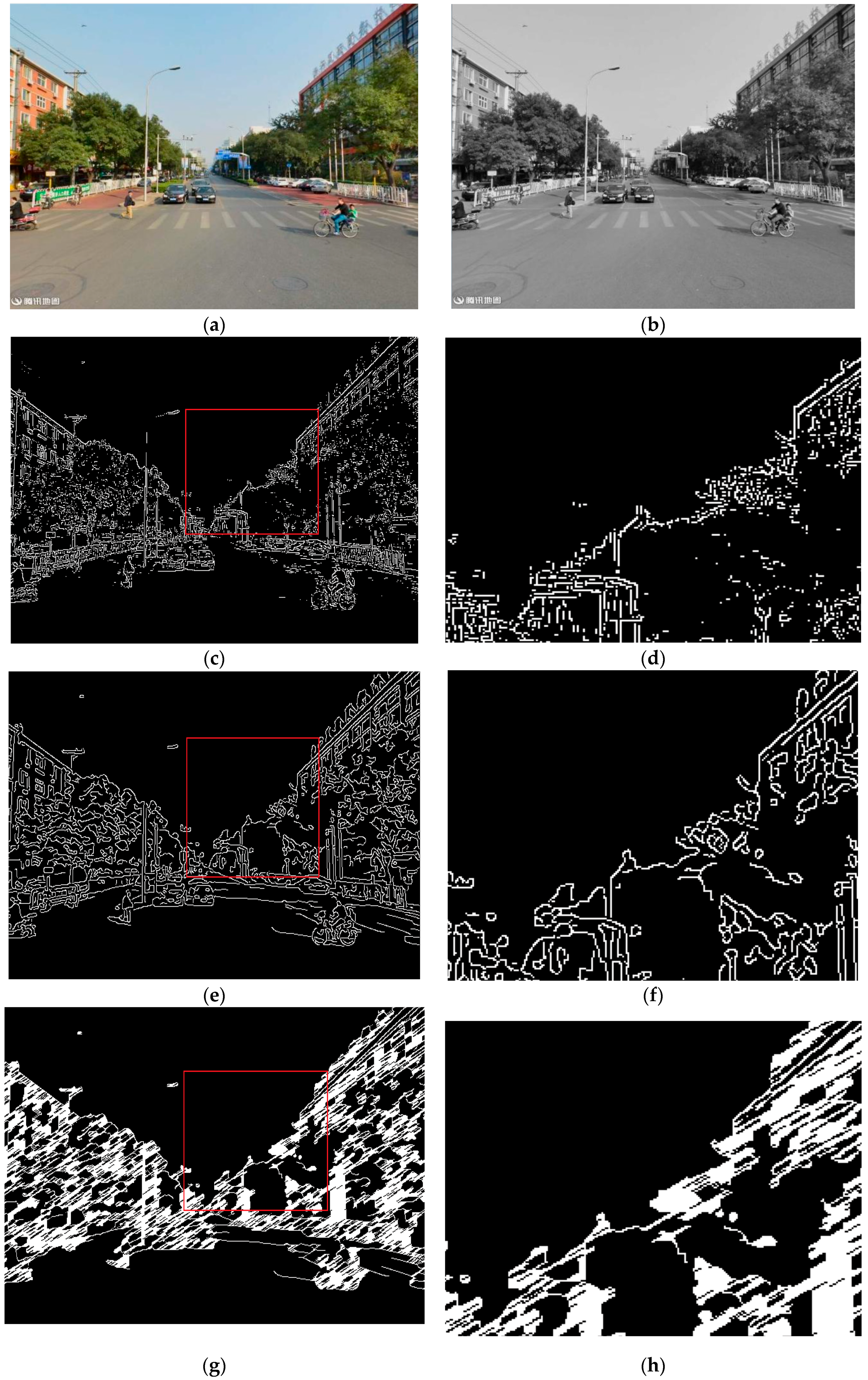
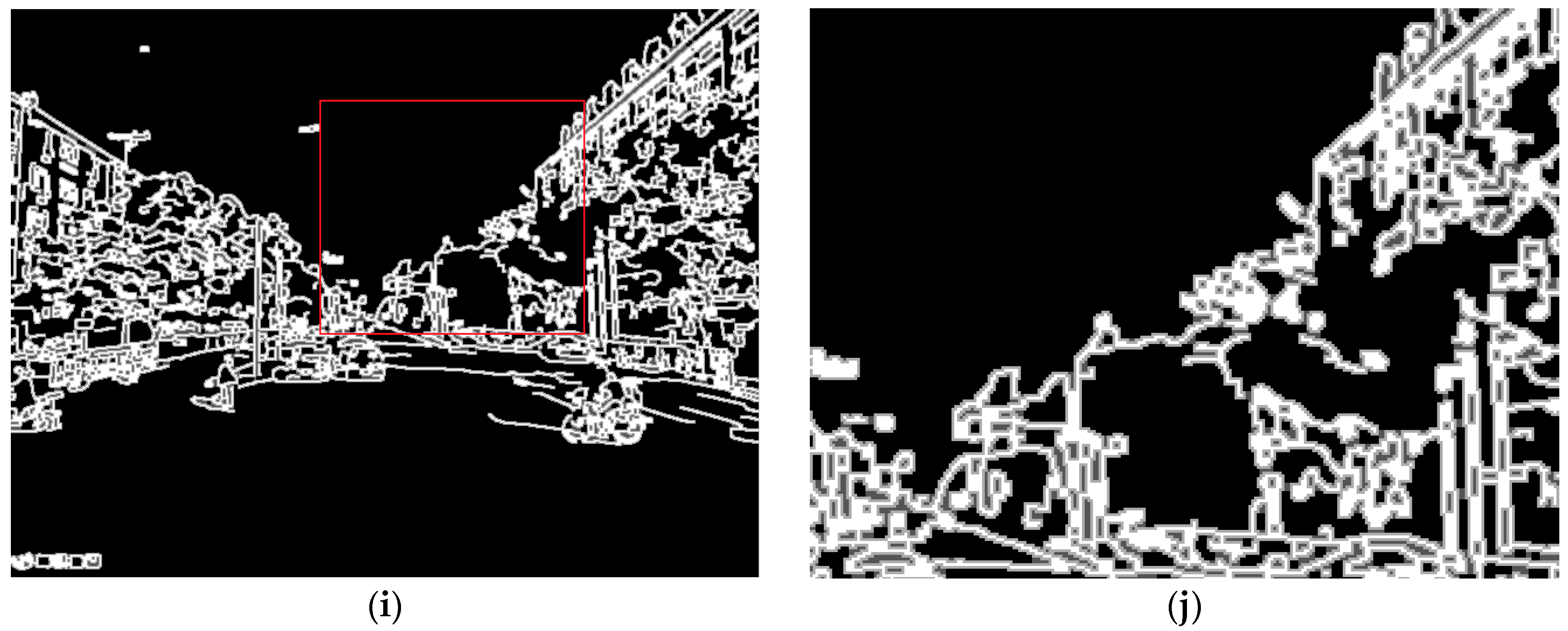
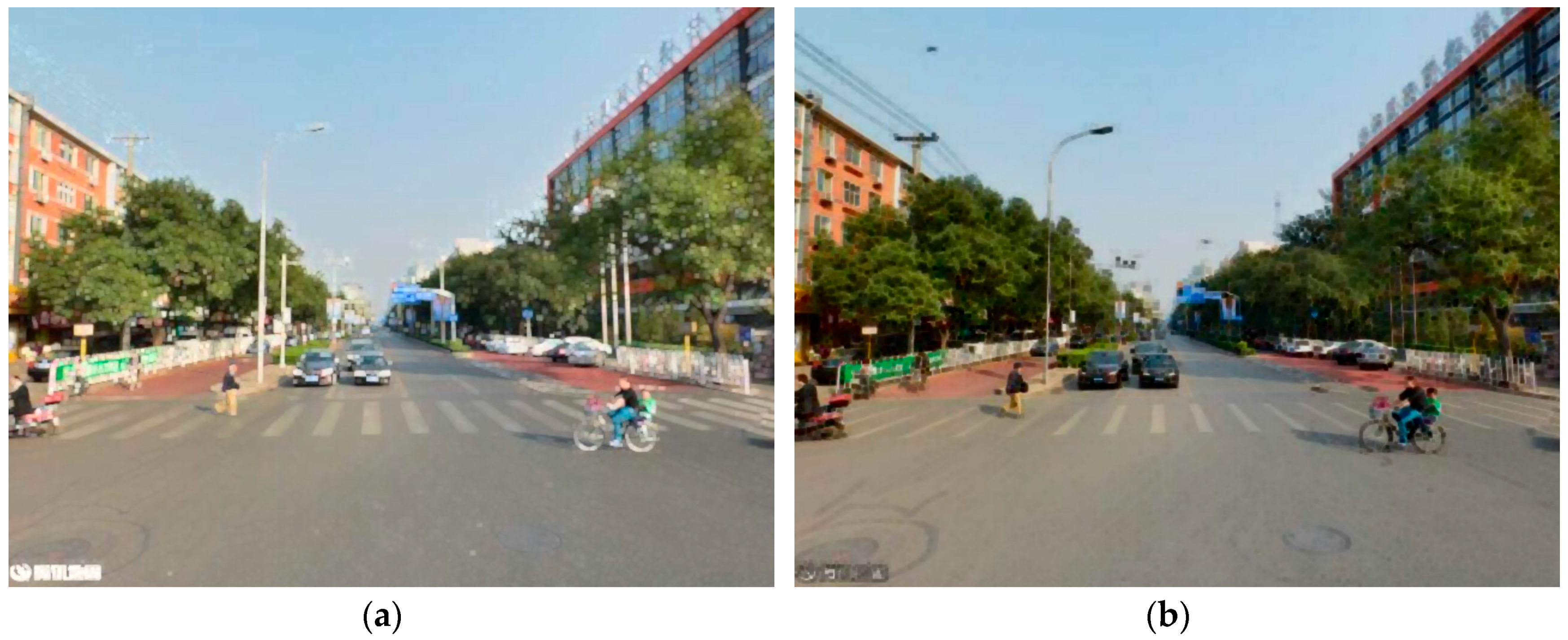
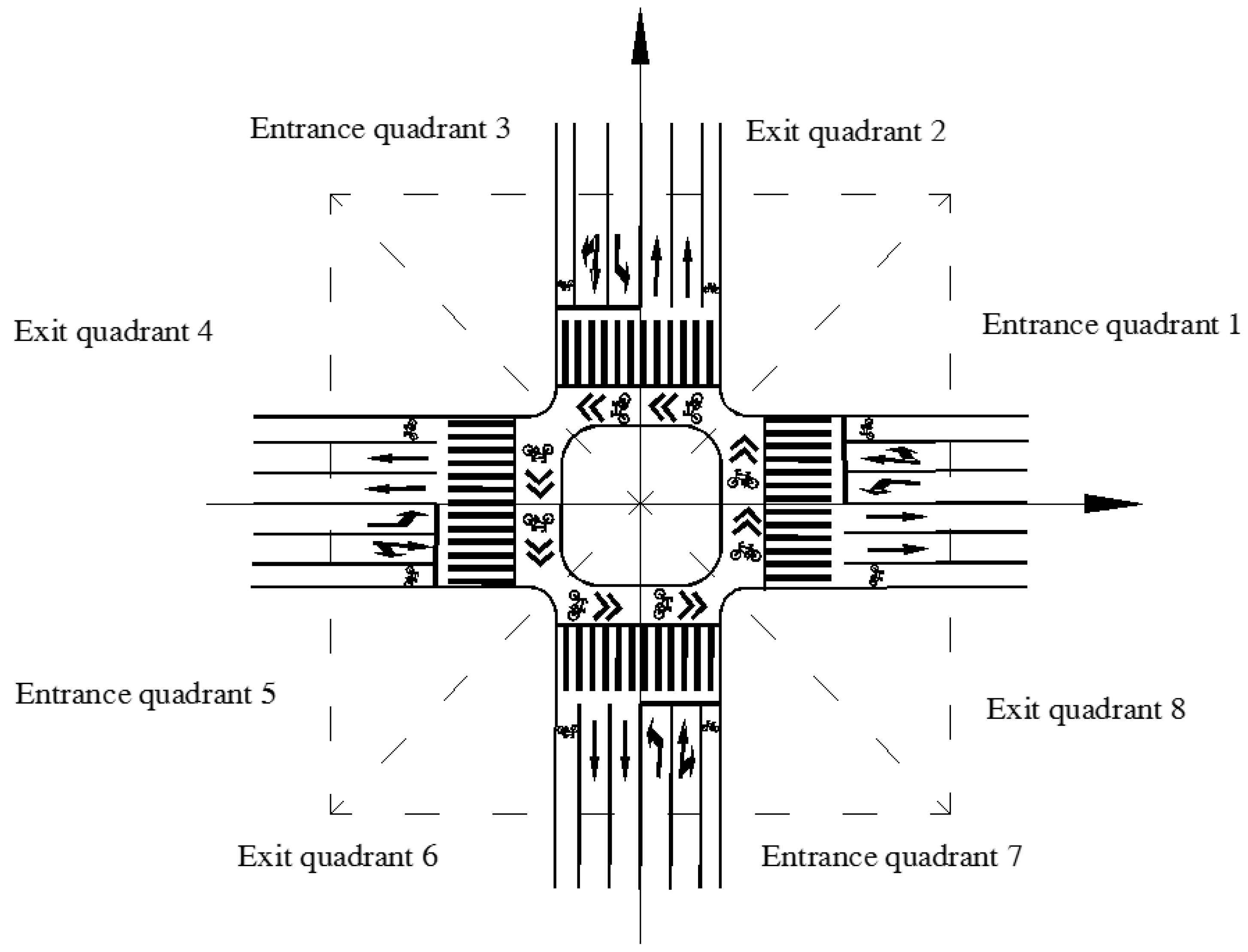


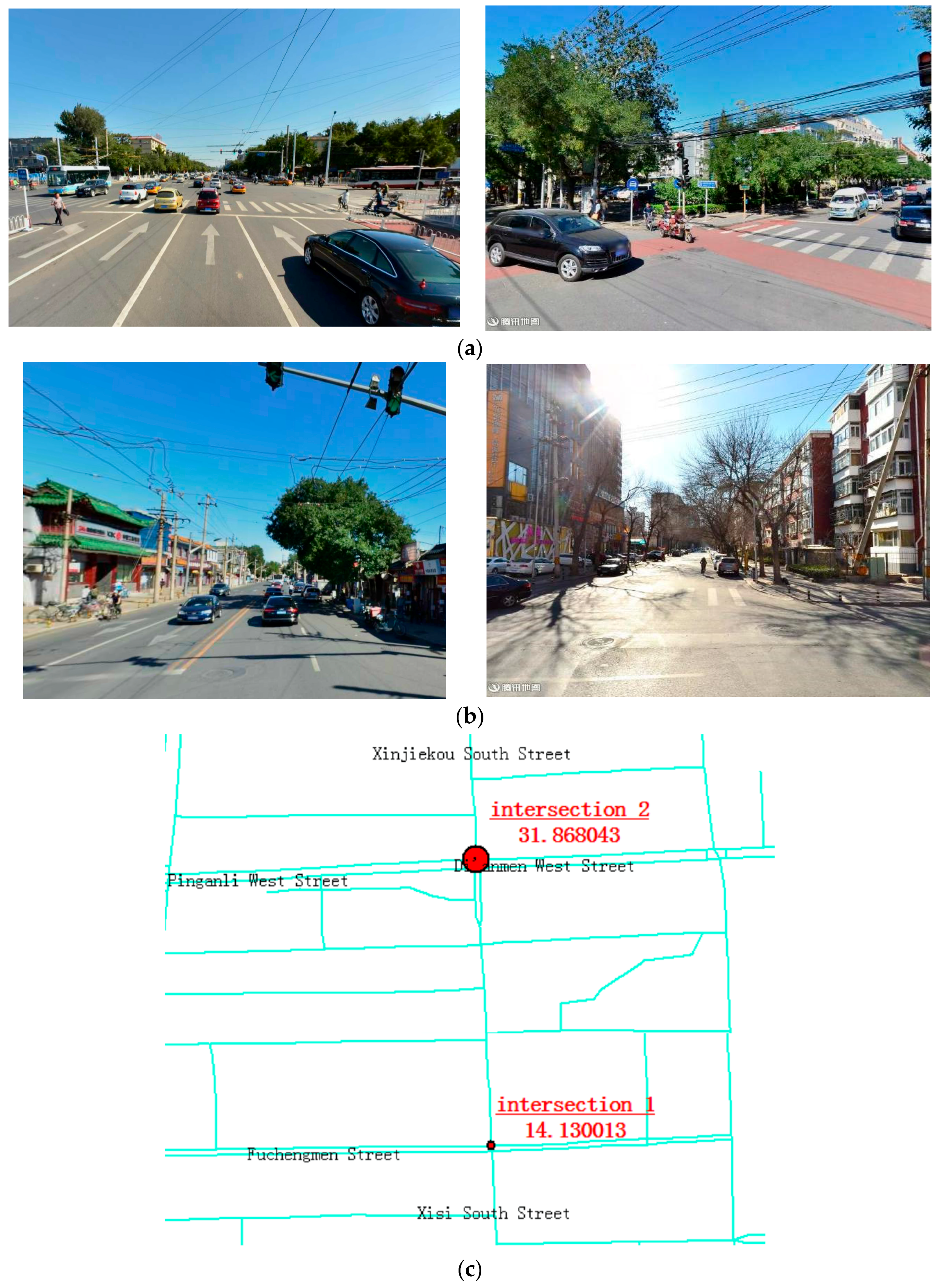
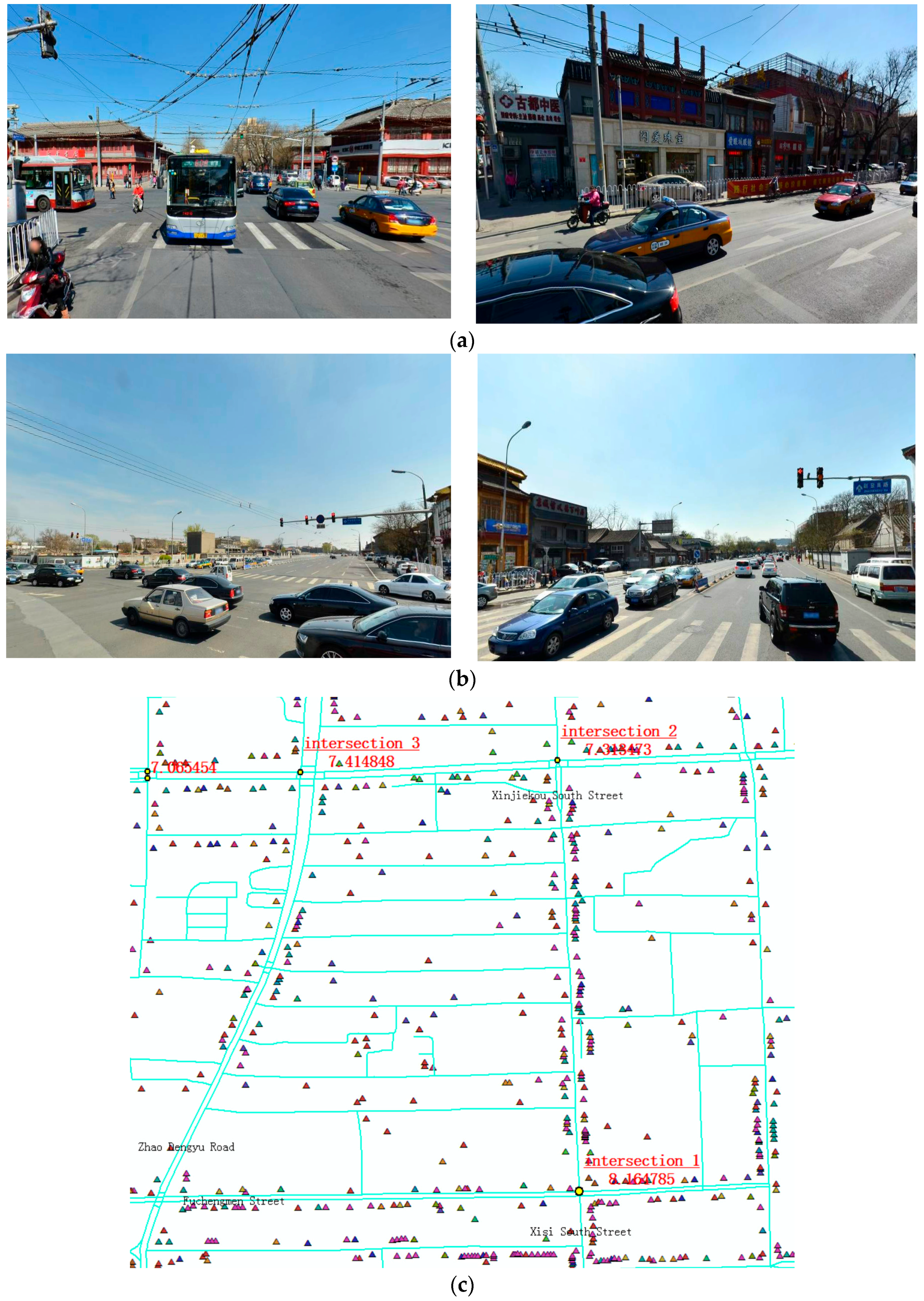
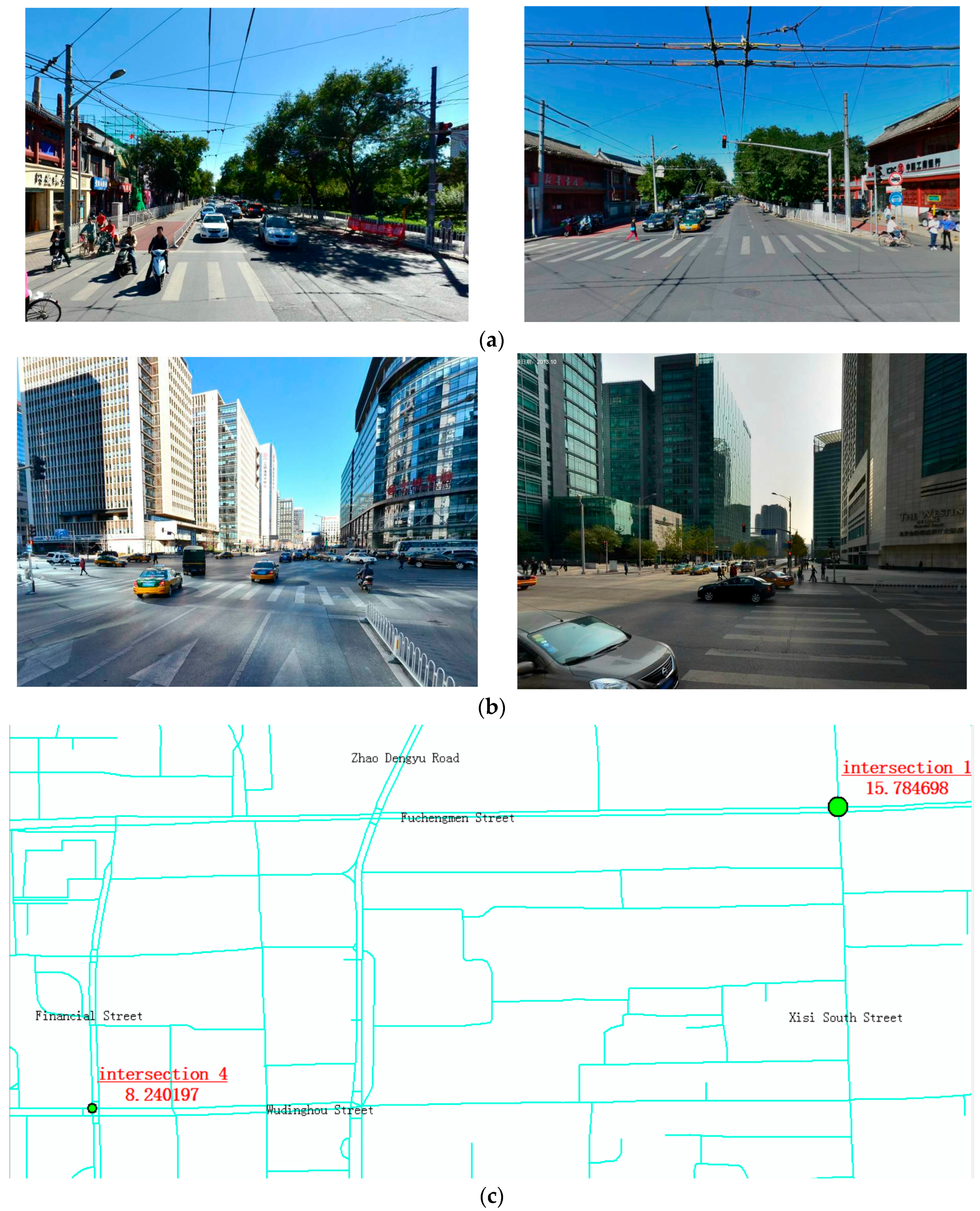
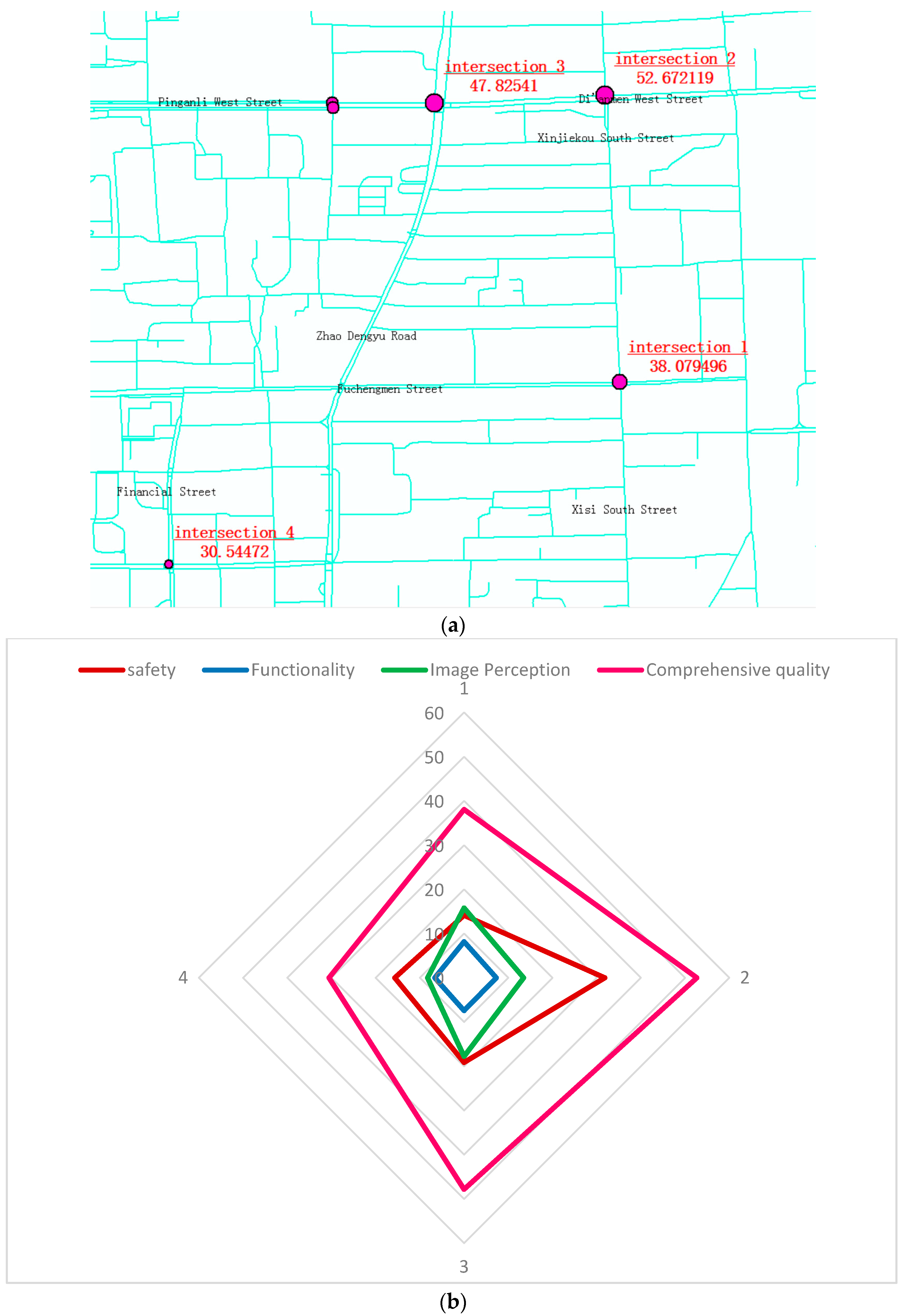
| Primary Indicator | Secondary Indicator (Abbr.) | Explanation of Indicators | Data Source |
|---|---|---|---|
| Safety | Conflict Point (CP) | The crossing point, merging point, and diverging point at an intersection | Conflict point model |
| Smallest Crossing Angle (SCA) | The smallest crossing angle between two crossed roads | Derived from the GIS data | |
| Exclusive Lane (EL) | If there is an exclusive lane or not | Traffic engineering database | |
| Boundary fence (BF) | If there is a barrier section between sidewalk, non-motorized vehicle lane, and motorized vehicle lane or not | Traffic engineering database | |
| Colored Bicycle Lane (CBL) | If the bicycle lane is colored or not | Traffic engineering database | |
| Functionality | Congestion Degree (CD) | The degree of congestion in peak hours | Tencent open platform |
| Node Degree (ND) | The number of roads connected to an intersection | GIS database | |
| Average Spacing (AS) | The average spacing from the neighboring intersection | GIS database | |
| Average Road Width (ARW) | The average width of roads connected to an intersection | GIS database | |
| Accessibility of Metro (AM) | If there is a metro station within 200 m | GIS database | |
| Accessibility of Bus (AB) | The number of bus lines (with stops) within 100 m | GIS database | |
| Diversity of Service (DS) | The number of kinds of POI within 200 m | GIS database | |
| Image perception | Opening Degree of Sky (ODS) | The ratio of sky area to the total area of the picture | Street view image processing |
| Brightness (BS) | Average value of brightness | Street view image processing | |
| Saturation (ST) | Average value of saturation | Street view image processing | |
| Continuity (CN) | The difference between areas of different brightness | Street view image processing | |
| Green Looking Ratio (GLR) | The ratio of green area to the total area of the picture | Street view image processing |
| Primary Indicator with Code and Weight | Secondary Indicator (Abbr.) | Weight of the Secondary Indicator |
|---|---|---|
| Safety 55.17 | Conflict Point (CP) | 33.45 |
| Smallest Crossing Angle (SCA) | 2.39 | |
| Exclusive Lane (EL) | 9.75 | |
| Boundary fence (BF) | 2.31 | |
| Colored Bicycle Lane (CBL) | 7.27 | |
| Functionality 15.57 | Congestion Degree (CD) | 1.53 |
| Node Degree (ND) | 0.36 | |
| Average Spacing (AS) | 7.00 | |
| Average Road Width (ARW) | 0.93 | |
| Accessibility of Metro (AM) | 2.33 | |
| Accessibility of Bus (AB) | 0.62 | |
| Diversity of Service (DS) | 2.80 | |
| Image Perception 29.45 | Opening Degree of Sky (ODS) | 9.36 |
| Brightness (BS) | 0.63 | |
| Saturation (ST) | 2.76 | |
| Continuity (CN) | 1.96 | |
| Green Looking Ratio (GLR) | 14.74 |
© 2017 by the authors. Licensee MDPI, Basel, Switzerland. This article is an open access article distributed under the terms and conditions of the Creative Commons Attribution (CC BY) license (http://creativecommons.org/licenses/by/4.0/).
Share and Cite
Zhang, Y.; Lu, H.; Luo, S.; Sun, Z.; Qu, W. Human-Scale Sustainability Assessment of Urban Intersections Based upon Multi-Source Big Data. Sustainability 2017, 9, 1148. https://doi.org/10.3390/su9071148
Zhang Y, Lu H, Luo S, Sun Z, Qu W. Human-Scale Sustainability Assessment of Urban Intersections Based upon Multi-Source Big Data. Sustainability. 2017; 9(7):1148. https://doi.org/10.3390/su9071148
Chicago/Turabian StyleZhang, Yuhuan, Huapu Lu, Shengxi Luo, Zhiyuan Sun, and Wencong Qu. 2017. "Human-Scale Sustainability Assessment of Urban Intersections Based upon Multi-Source Big Data" Sustainability 9, no. 7: 1148. https://doi.org/10.3390/su9071148





